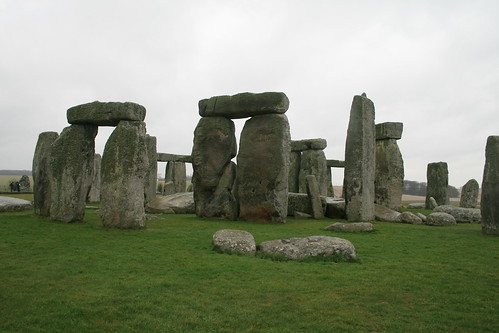
During our trip to England, the weather was always a little dicey but the worst of it was the morning we went by Stonehenge on our way to Bath. When we arrived, the overcast weather had changed from misty to a windy driving drizzle if that is possible. As we walked along the path surrounding the monoliths, the rain soaked us while the wind popped umbrellas.
Most people’s reaction to seeing Stonehenge, much like seeing Angelina Jolie, is to notice how much smaller it is than they expected. I don’t know what they were expecting, but I thought it was plenty large. Too big to fit on a stage with David St. Hubbins and Derek Smalls. Part of that perception might come because you aren’t really allowed too close to the rocks. I imagine they are a lot more impressive if you are looking up at them rather than staring at them from across a field.
Rather than quibble with its size, I prefer to be amazed by its age. These stones, some weighing as much as fifty tons were moved over two hundred miles and set up like kids’ blocks. And they’ve mostly remained standing for a couple of thousand of years.
National Geographic just did a big cover story on the meaning of Stonehenge and their conclusion was “No one knows.” The Washington Post today has a story saying that it was a rich family's private burial plot. I still hold to the theory that it was landing lights for George Jetson to visit Fred Flintstone. Suffice it to say, the arguments will go on.
Since this was perhaps the one chance in my lifetime to see this five-thousand year old site, I was determined to get some photos despite the uncooperative weather. You can see one of my shots below:

National Geographic is of course famous for its fantastic photography. Below is one of their pictures:

That is pretty much the same angle as mine only done with more talent and panache. Amazing what a couple of thousand dollars worth of equipment, carte blanche access, and cooperative weather can do. Ken Geiger, the photographer, explains how he got his amazing shots in this article. A lot of the special lighting was done by light sculpting during extremely long exposure shots. He used fifteen specialty flashlights that cost $400 each. Not something I have in my camera bag of tricks.
You can see more of my picture in this Flickr set. You can see National Geographic’s special on this ancient temple/graveyard/night club (one of the theories is that it was used for special fertility mating rituals) on the National Geographic Channel June 1st (check local listings, yadda, yadda, yadda). And maybe someday we will solve the many mysteries of Stonehenge. Like how Clark Griswold managed to knock them down so easily.
BlatantCommentWhoring™: Impressive, or just a pile of rocks?
4 comments:
I visited Stonehenge a few summers ago and, as you mentioned, I was also surprised at how small it was. Somewhere along the line I had gotten the impression that the Henge was much bigger -- perhaps because most photographs I've seen have shown just the stones, and no people around for useful size references.
It was nice to see, I guess -- but I was a lot more interested in the more recent old things we saw in England:the Globe, St Paul's, the Tower, etc. (But more than those, I think, the English countryside -- we stayed in the South Downs for a week, in a little cottage surrounded by wheat and barley fields, and it was breathtaking).
I was not one who thought it was smaller, I thougt it was bigger! It was really neat to see and think of why and how it got there!
Thank you for posting that Spinal Tap link. That movie is in my list of top 5 all time favorites (and quotable).
Great laugh to start the day!
Your photos of stonehenge look very much like my photos of stonehenge! Yes, it is indeed possible to get windy driving drizzle. You can get all kinds of drizzle, it's one of the things we specialise in! That Nat Geog pic is gorgeous.
For the record, I thought it was bigger too, and I'm English!
Post a Comment